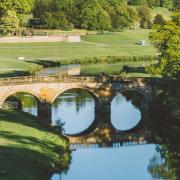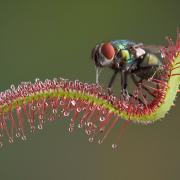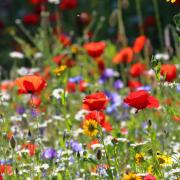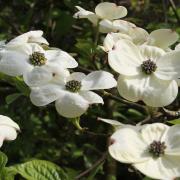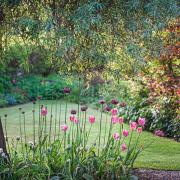Griselda Kerr continues her seasonal series on caring for our national emblem
Mid-winter roses – could there be one or two roses still attempting to flower in your garden? I find roses and snow one of the most smile provoking combinations illustrating just what a gutsy plant the rose is. Some do have ridiculous staying power to bring an extraordinary flash of colour on a winter day. ‘Bonica’, ‘Jaqueline du Pre’ and ‘Cornelia’ are three in my garden that have, until very recently, been trying to pretend it is bikini weather. They were flowering so well in October and November that they avoided the secateurs treatment in October and just went on enjoying life. Now however all the roses are under Starter’s Orders for the new year ahead.
First of all is the soil preparation: make sure the roses start their new year clean – any leaves left on the plant with any trace of black spot should be taken off. Then rake the soil beneath the rose to remove all leaf litter and last year’s debris so that you start with an immaculately clean bed. Roses like a soil on the acidic side of neutral (ideally 5.5pH–6.5pH) so, as my soil is more alkaline, I spray the earth beneath the roses with Sulphur Soil (sulphur chips) in February before growth starts. I take care to follow the instructions on the packet precisely as, should there be a serious overdose of sulphur the soil will not recover. But follow the directions and all will be very well. The effect of sulphur soil lasts six months so there is no need to do another application until the autumn. If of course your soil is on the acidic side of neutral, you would not want to apply Sulphur Soil. Helen Yemm wrote some months ago about her treatment of roses plagued with black spot: she applied Sulphur Rose (as opposed to Sulphur soil) to the plants during winter so that the sulphur got into the cracks of the roses where the black spot was still lurking – so there is another wonderful tip from her. So, spray the soil before growth starts and again at bud burst a few months hence.
Now comes the pruning, done in mid-February in the south but probably not till early March in the colder areas of Derbyshire – and not when it is deeply frosted weather. When you prune, disinfect secateurs regularly so you do not spread disease from one to another and keep them sharp. Prune to a bud that is in the direction you want it to grow – normally outward facing - and try not to remove more than one third of the rose in any one year unless it needs really radical treatment. New shrub roses can be left alone for their first four years to build up strength. Roses that flower only once – that is Damasks, Gallica, Scots and Sweet Briar, Hybrid Musks, Rugosa, Moss, Alba, Centifolias, species roses and spreading ground cover roses need no pruning at all at this time of year unless there is obvious dead wood which needs taking out or they have got quite out of control. Their graceful shape can be spoilt by shortening stems now. Improving their shape by making them less congested is better done immediately after flowering so leave alone for the time being.
Repeat flowering shrub roses (‘Old English’ roses and also Bourbon, China and Portland) are the roses in need of the most attention to their structure now. Take out crossing or rubbing branches, take out at the point of origin one of any two close ‘double’ branches – ie where two branches start from the same point prune out the weaker one to ease congestion, take out any weedy and spindly branches and finally make sure the shrub is open in the middle so that when it is in full leaf, air can circulate well. If Black spot was prevalent last year, look out for the tell-tale signs that it is ready to return – infected stems have black/purple blotches so cut them out as vigorously as you dare. If the rose is congested at the base you can take one or two of the oldest stems right out from the middle to reinvigorate the plant. Make sure you like the overall shape and when all is done you will ideally have reduced the overall height by about a third.
Hybrid Tea roses and to a slightly lesser extent Floribundas are pruned much harder to encourage young vigorous growth. Patio roses can have their twiggy growth removed and the main stems reduced by about a third. Small groundcover roses can be hard pruned if there are wayward stems and strong shoots can be shortened by about a third with side shoots taken back to two to three buds. Standard roses (which are grafted onto a tall trunk), need to be pruned according to the cultivar being used so that a repeat flowering standard will be pruned as a repeat flowering shrub rose, a hybrid or floribunda rather harder.
Climbers can be pruned anytime in winter – cut some of the oldest woody branches to the ground if the rose is becoming congested, get rid of dead stumps at the bottom by sawing them off, bend into horizontal any long ‘leaders’ and then cut them by about a third to a half to encourage branching, shorten laterals and cut off any spurs on these laterals to two to three buds. Take off any spindly growth, crossing branches, dead or dying wood. Routine pruning of Ramblers should happen after flowering but if you need to renovate a rambler then now is a good time as you can see what you are doing. You can cut stems out from the ground and reduce the overall mass. You may not get many flowers next year but it will grow back vigorously. Having looked after the soil and completed the pruning, the final task is feeding the roses – having been pruned, they will be hungry. A granular rose fertiliser that is high in potash is better than a lot of nitrogen at this stage. Two ounces per square yard is what is normally recommended. Just as important now is a good mulch of the richest organic matter you can find, right up to the stem and about 2” deep. Feeding the roses will be done again at bud burst. I find it useful to use Sulphur Rose now to help prevent the spread of black spot and powdery mildew. This treatment, for my alkaline soil, should be repeated every month (if only one practised what one preaches) but I also use a granular rose feed once at bud burst and again after the first flush is over. It is interesting that roses were less troubled by black spot before the Clean Air Act of 1968 when there was more sulphur in the air. If your soil is on the acidic side of neutral, a slow release feed such as Nutrarose Micro at bud burst will maintain the acidic soil condition and feed the roses for a whole season.
Pruning sounds complicated – no rose was ever killed by lack of pruning and many lose the joy of their shape by over pruning. Roses reshoot very willingly from dormant buds so you can be brave to encourage the good growth and openness but I would just stress the importance of knowing whether they flower once and have produced their flowering wood for next year or flower again and again on new wood. So, having been under starter’s orders, they are off – clean, pruned, fed and ready for a beautiful rose season in four months’ time.
Tips from Ian Limmer at Peter Beales Roses
• I like to prune three times in the winter: Climbers and Ramblers before Christmas, Shrub roses in February, and March for Modern roses. This helps us as we all lead very busy lives.
• During January and February if there are cold spells of -15C and below, fleece your Teas and China roses.
• To get the best from your Climbers so they do not all flower at the top of the plant lay the stem horizontally or, if there is not enough room to do this, stagger your pruning.








